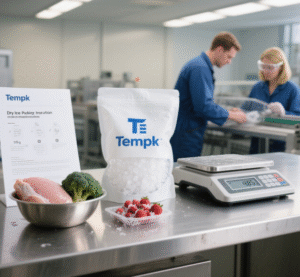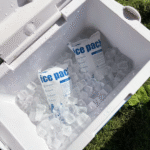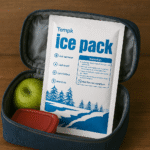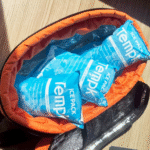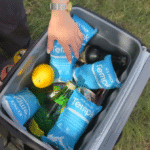Pengepakan Es Kering Petunjuk (2025): Sebuah Praktis, Cara yang Sesuai
Menggunakan kemasan ventilasi, tanda “Es Kering”/“Karbon dioksida, padat" + Dan1845, menambahkan massa es kering bersih di kg di paket luar, dan terapkan a Kelas 9 label bahaya (minimal 100×100mm). Untuk udara, mengikuti Ini PI954, menghormati ≤200kg per paket topi, dan sertakan saluran es kering di Di waybill (AWB):UN 1845, Dry Ice, x packages × y kg (net per package) (tidak ada Pernyataan Pengirim saat pendinginan non -dg; variasi operator/negara bagian mungkin berlaku).
USPS berbeda: surat udara domestik ≤5 pon es kering per potong Dan membutuhkan a Deklarasi Shipper ditempel; surat internasional dengan es kering dilarang.
-
1) Aturan apa yang sebenarnya berlaku di dalamnya 2025
-
2) Tanda, Label, ukuran—persis apa yang dibawa ke mana pun
-
3) Berapa banyak es kering untuk digunakan (kalkulator & aturan praktis)
-
4) Paket langkah demi langkah (selaras dengan PI954)
-
5) Spesifik operator: Fedex, UPS, USPS
-
6) Paket es kering untuk pengiriman makanan (resep praktis)
-
7) Keamanan (Paparan co₂, ventilasi, pembuangan)
-
8) 2025 pembaruan untuk ditonton
-
9) FAQ
1) Aturan apa yang sebenarnya berlaku di dalamnya 2025
Udara (global): DI SINI DGR PI954 mengatur es kering (Dan1845). Itu membutuhkan ventilasi kemasan, sesuai tanda & pelabelan, itu massa es kering bersih dalam kg pada paket, Dan AWB informasi ketika Pernyataan Pengirim tidak diperlukan (YAITU., es kering hanya digunakan sebagai pendingin untuk barang-barang yang tidak berbahaya). Operator mungkin mengenakan biaya variasi dan meminta Anda menyatakan berat es kering pada saat pemesanan.
KITA. (semua mode / spesifikasi pesawat): 49 CFR §173.217 memerlukan kemasan ventilasi Dan massa bersih (kg) di luar untuk udara. Dokumentasi untuk pengangkutan es kering melalui udara yang hanya digunakan sebagai zat pendingin umumnya ditangani di AWB ketika tidak diperlukan DGD.
surat USPS (jaringan pos): USPS Instruksi Pengemasan 9A topi udara kiriman surat di ≤5lb es kering per potong, memerlukan Kelas 9 pelabelan dan tanda, Dan memerlukan Deklarasi Pengirim untuk surat udara; surat internasional dengan es kering dilarang. (Aturan surat permukaan USPS berbeda.)
jalan UE (ADR): Es kering yang digunakan sebagai pendingin adalah tidak dikenakan ADR di luar bagian5.5.3 (ketentuan gas asfiksia)—fokus pada ventilasi kendaraan dan penandaan paket/kendaraan yang mungkin berlaku dalam skenario risiko ventilasi.
2) Tanda, Label, ukuran—persis apa yang dibawa ke mana pun
Pada paket luar (udara):
-
Nama pengiriman yang tepat: "Es kering" atau “Karbon dioksida, padat"
-
Dan1845
-
Massa bersih es kering dalam kilogram (kg saja)
-
Kelas 9 label bahaya, minimum 100 mm×100mm
-
Pengirim & alamat penerima barang (panel yang sama jika memungkinkan)
Aturan praktis yang menghentikan penolakan: Simpan label Class9 jernih (Jangan menulis di dalam berlian). Meletakkan Dan1845 Dan Kg net bersebelahan dengan Kelas 9 ketika ruang memungkinkan. Gunakan jalur AWB untuk kargo non-DG yang didinginkan dengan es kering.
Mengapa ventilasi itu penting: Kemasan harus mengizinkan pelepasan CO₂; wadah yang tertutup rapat bisa pecah. Itu adalah persyaratan dalam 49 CFR §173.217 dan tercermin dalam alat bantu pekerjaan operator.
Batasan jumlah paket: Di bawah PI954, yang khas es kering bersih maksimum per paket adalah 200kg (operator dapat menetapkan batas bawah).
3) Berapa banyak es kering untuk digunakan (kalkulator & aturan praktis)
Metode rekayasa (paling akurat):
Es kering menyerap ~571 kJ/kg pada sublimasi. Perkirakan pengirim Anda perolehan panas (kj / jam), kalikan dengan jam transit, Kemudian 571 untuk mendapatkan kg es kering; menambahkan +20–30% buffer untuk serah terima atau rute panas.
-
Rumus:
Dry‑ice kg ≈ (Heat gain kJ/h × Hours) / 571, lalu × 1.2–1.3 (penyangga) -
Sumber entalpi: Buku Web Kimia NIST.
Aturan praktis lapangan (perencanaan cepat):
Rencanakan ~5–10 pon (2.3–4.5kg) per 24 jam di sebuah terisolasi dengan baik pengirim; blok bertahan lebih lama dari pelet. Mulai di kelas bawah dalam VIP/EPS tebal; menambahkan +25–50% untuk jalur panas (> 90°F) atau isolasi tipis.
Penempatan: Blok muatan atas dan kelilingi dengan pelet; gas dingin wastafel, jadi pendinginan dari atas ke bawah menjadi efisien. (Rekomendasi bimbingan universitas dan operator penempatan teratas.)
4) Paket langkah demi langkah (selaras dengan PI954)
-
Prasyarat: Produk beku; dinginkan terlebih dahulu bagian dalam pengirim.
-
Pilih insulasi berkemampuan ventilasi: EPS/EPP/VIP atau sistem yang divalidasi; tidak kedap udara liner/tutup.
-
Garis & memisahkan: Poli liner/penyerap sesuai kebutuhan; cegah kontak langsung es kering dengan makanan yang tidak dikemas.
-
Memuat & posisikan es kering: Blok di atas, pelet di sekitar sisi; menstabilkan rongga untuk mencegah pergeseran.
-
Tutup—tetapi jangan sampai kedap udara: Rekatkan karton luar tetapi pertahankan jalur ventilasi.
-
Terapkan tanda & Label: “Es Kering/Karbon dioksida, padat,” Dan1845, Kg net, Kelas9 (100×100mm).
-
Dokumen lengkap: Untuk non-DG didinginkan dengan es kering, pasang saluran es kering di AWB; periksa variasi operator/negara bagian.
-
Lembut & melacak: Kirim di awal minggu; menggunakan data logger untuk jalur bernilai tinggi.
5) Spesifik operator: Fedex, UPS, USPS
-
Fedex (udara): Di atas kertas tagihan udara, memeriksa “Pernyataan Pengirim TIDAK Diperlukan” (ketika es kering hanya mendinginkan non-DG). Gunakan sintaks AWB ini:
UN 1845, Dry Ice, __ x __ kg(paket × kg bersih per paket). Juga, Label Class9 harus berukuran ≥100×100mm; jangan menulis di dalam berlian. -
UPS: Harapkan sebuah audit penerimaan. Tanda “Es kering/karbon dioksida, Padat" + Dan1845; menyimpan paket ventilasi; Panduan layanan kesehatan UPS juga sejalan dengan hal tersebut 5–10lb/24h aturan perencanaan.
-
surat USPS: Udara domestik: ≤5lb per milPiece + Kelas9 + penandaan yang diperlukan Dan A Pernyataan Pengirim ditempel. Internasional: dilarang.
6) Es kering paket untuk pengiriman makanan (resep praktis)
-
Target: Simpan makanan beku di bawah 0°C selama 48 H pada layanan 2 hari.
-
Mulailah dengan: 10–20lb es kering untuk a EPS sedang (20–30qt) pengirim (peningkatan di musim panas atau dinding tipis).
-
Metode: Barang yang dibekukan terlebih dahulu, sejajar dengan poli, muatan top balok es kering, isi rongga samping dengan pelet/busa, menyimpan jalur ventilasi.
-
Pelabelan: “Es Kering/Karbon dioksida, padat,” Dan1845, Kg net, Kelas9.
Ingin menargetkan kata kunci “paket es kering untuk pengiriman makanan” lebih langsung? Tautkan bagian ini ke halaman resep yang lebih dalam (pusat dalam) dengan foto paket dan kalkulator.
7) Keamanan (Paparan co₂, ventilasi, pembuangan)
-
Batas paparan: Osha PEL 5,000 ppm (8-H dua); STEL 30.000ppm. NIOSH IDLH 40.000 ppm. Gunakan ventilasi dan hindari ruang terbatas dan kendaraan tanpa aliran udara.
-
volume gas: ~250L CO₂ per pon es kering—salah satu alasannya kedap udara adalah sulit TIDAK.
-
APD: Sarung tangan terisolasi dan pelindung mata; Hindari kontak kulit langsung (Risiko Frostbite).
-
Pembuangan: Biarkan sisa es kering sublim di area yang berventilasi; tidak pernah di wastafel/ruangan tertutup (risiko penumpukan tekanan/CO₂).
8) 2025 pembaruan untuk ditonton
-
Iata 2025 daftar periksa penerimaan: IATA menerbitkan a 2025 Daftar Periksa Penerimaan Es Kering templat; operator dapat meminta menyatakan es kering bersih saat pemesanan untuk mengatur batas CO₂ pesawat. Lanjutkan untuk memeriksa variasi operator/negara bagian.
-
Edisi Inti DGR: Itu 66Edisi ke-th (efektif 1 Januari 2025) sedang berlaku; tambahan dapat memperbarui kata-kata daftar periksa—tetap mengikuti perkembangan situs IATA dan bantuan pekerjaan operator Anda.
9) FAQ
Q1: Apakah ada hard maksimum per paket lewat udara?
A: Biasanya ≤200kg es kering bersih per paket di bawah PI954; Maskapai penerbangan dapat menerapkan batasan yang lebih rendah atau batasan tipe pesawat. Selalu verifikasi variasi operator.
Q2: Apakah saya memerlukan deklarasi pengirim (DGD) untuk es kering?
A: Bukan ketika es kering hanya pendinginan Barang non -berbahaya di kargo udara—gunakan AWB pintu masuk. Jika mendingin barang berbahaya, diperlukan DGD. Catatan: USPS Air Mail memerlukan DGD bahkan untuk non-DG yang didinginkan dengan es kering.
Q3: Pound atau kilogram di kotak?
A: Kilogram diperlukan pada paket luar untuk pengiriman udara (massa es kering bersih).
Q4: Apa kesalahan pelabelan yang paling umum??
A: Hilang Kg net dan berukuran kecil Kelas9 Label. Menggunakan 100 × 100mm minimum; jangan menulis di dalam berlian.
Q5: Bisakah saya mengirim paket berpendingin es kering melalui USPS secara internasional?
A: TIDAK. Surat internasional yang berisi es kering adalah dilarang oleh USPS






